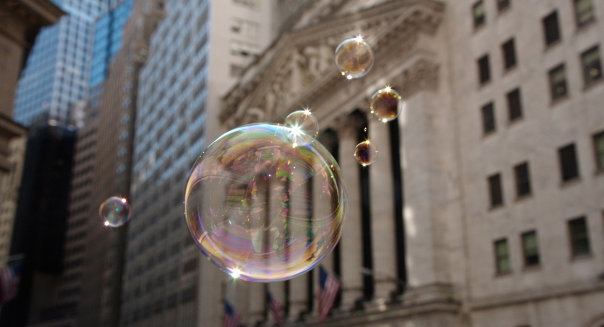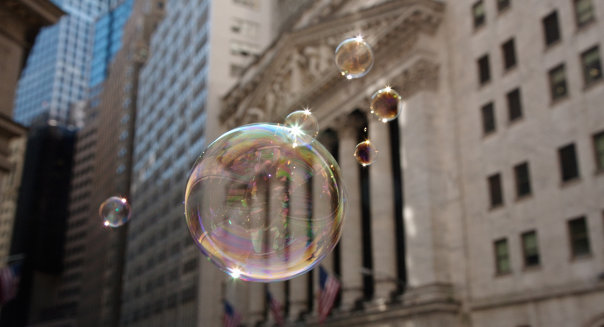
A sharp rise in U.S. equity prices could be leading to a dangerous bubble, according to one of the three Americans who won the 2013 Nobel prize for economics.
“I’m not sounding the alarm yet. But in many countries the stock price levels are high, and in many real estate markets prices have risen sharply … that could end badly.”
“I find the boom in the U.S. stock market most concerning,” Robert Shiller said in an interview with Germany’s Der Spiegel magazine published Sunday.
He added that this was a key concern because the U.S. economy was “still weak and vulnerable.” The real estate market in Brazil was also worrying, he said. He said that at a recent conference he attended in the country, the sharp jump in house prices had been attributed to a growing middle class and a positive economic developments.
He saw many similarities with the U.S. housing boom of the mid-2000s.
“The world is still very vulnerable to bubbles,” he said.
Schiller won the Nobel prize economics in October for his research that has improved the forecasting of asset prices in the long term and helped the emergence of index funds in stock markets.
He was awarded the 8 million crown ($1.25 million) prize alongside fellow economists Eugene Fama and Lars Peter Hansen.
At the ceremony in Sweden, Schiller told Reuters news agency that the Federal Reserve’s economic stimulus and growing market speculation were creating a “bubbly” property boom.
“This financial crisis that we’ve been going through in the last five years has been one that seems to reveal the failure to understand price movements,” Shiller told Reuters.
He didn’t mention a bubble in U.S. stocks back in October, but has now added that to his list of growing concerns. The S&P 500 Index (^GPSC) is now higher by 26.6 percent since the start of the year, logging its longest weekly winning streak since 2004 on Friday.
Both the Dow (^DJI)and the S&P 500 are regularly breaking fresh new all-time highs and the Nasdaq (^IXIC) is trading at levels not seen since the dot-com boom went bust in 2000.
Marc Faber, editor and publisher of The Gloom, Boom & Doom Report, told CNBC on Friday he believes a “massive speculative bubble” has encroached on everything from stocks and bonds to alternative currency bitcoin and farmland. He attributed the vast bubble to “symptoms of excess liquidity.”
The U.S. Federal Reserve has embarked on quantitative easing in recent years and is currently pumping $85 billion into the economy every month. This extra liquidity has been joined by similar programs in the U.K. and Japan.
Analysts cite this extra liquidity as a reason for the global equity rally this year, but many are now starting to grow cautious amid uncertainty over whether the Fed will taper its bond purchases in the coming months.
Tom Elliot, an international investment strategist at DeVere Group told CNBC Monday that fledgling U.S. growth and quantitative easing were two pillars that were currently propping up the U.S. economy. He was concerned that no one had any idea what would happen if one of those pillars was removed.
“We’ve got no idea whether the wall will hold,” he said.
Faber: ‘We Are In a Massive Speculative Bubble’
The Fed Has Created a Huge Global Bubble: Stockman
Art Cashin: Here Are the 3 Biggest Risks to Stocks
Satellite radio has never been more popular. There are now 23.9 million subscribers after the parent company of Sirius and XM closed out 2012 with 2 million more accounts than it had when the year began.
However, Sirius XM lost its longstanding CEO late last year, and a media conglomerate has acquired a controlling stake in the satellite radio provider — events that have triggered uncertainty.
Still, Sirius XM is a company that has been consistently profitable and generating growing amounts of revenue and free cash flow on its own. And, auto sales also remain strong: Those represent the largest source of new subscribers for Sirius XM, as most of its users tune in through car factory-installed receivers.
Sirius XM Radio
A few years ago, Nokia was the undisputed top dog in mobile phone handsets. The Finnish company was a global juggernaut at a time when consumers were swapping beepers — remember those? — for wireless phones.
But the market has evolved repeatedly since then. Cheaper feature phones have been replaced by smartphones that run apps and surf the Web, and Nokia has been slow to embrace the platforms that matter. Obviously it couldn’t put out an iPhone, but it also wasn’t able to match Samsung’s early push into Android devices that are now globally popular.
Nokia is accepting billions to back Microsoft’s fledgling Windows Phone mobile operating system, but the stock has been stuck in the single digits for more than two years.
Nokia
It isn’t easy being a regional telco, offering up landlines, Internet, and cable TV to rural markets.
A big draw for investors in Frontier Communications is its meaty dividend payout. Even after slashing its quarterly rate from $0.1875 a share to $0.10 a share last year, the stock’s still yielding 10 percent. The large dividend is significant, since shorts actually have to cover that when it gets paid out.
Analysts see revenue and profitability continuing to decline here, and pessimists are holding out for more dividend cuts in the future.
Frontier Communications
The old "Intel inside" ads came out at a time when PC sales were booming. Manufacturers were hopping on Intel microprocessors to power desktops and laptops, only turning to smaller rival Advanced Micro Devices (AMD) when they wanted to show Intel that they weren’t entirely dependent on the chip giant.
But the tech world have taken an "Intel outside" approach in recent years. PC shipments have fallen for two years, and Intel’s efforts to get its chips into the smartphones and tablets that people are actually buying haven’t been effective enough to offset its declines on the PC side.
Intel
The poster child for the "too big to fail" banking giants is starting to bounce back.
Bank of America stock hit a fresh 52-week high this month, and regulators finally eased up on the bank after it cleared its stress test. That freed Bank of America to return more of its money to shareholders beyond its token quarterly dividend of $0.01 a share, and the financial services giant’s first move was to declare a huge share repurchase program.
As long as the housing market holds up and the general state of corporate America makes lending money to companies a smart bet, Bank of America will do just fine. Shorts, naturally, don’t see it that way at all.
Bank of America
Top Stories
How to Invest
The Fool Store: Advisors and Plans
More From the Motley Fool


Leave a Reply